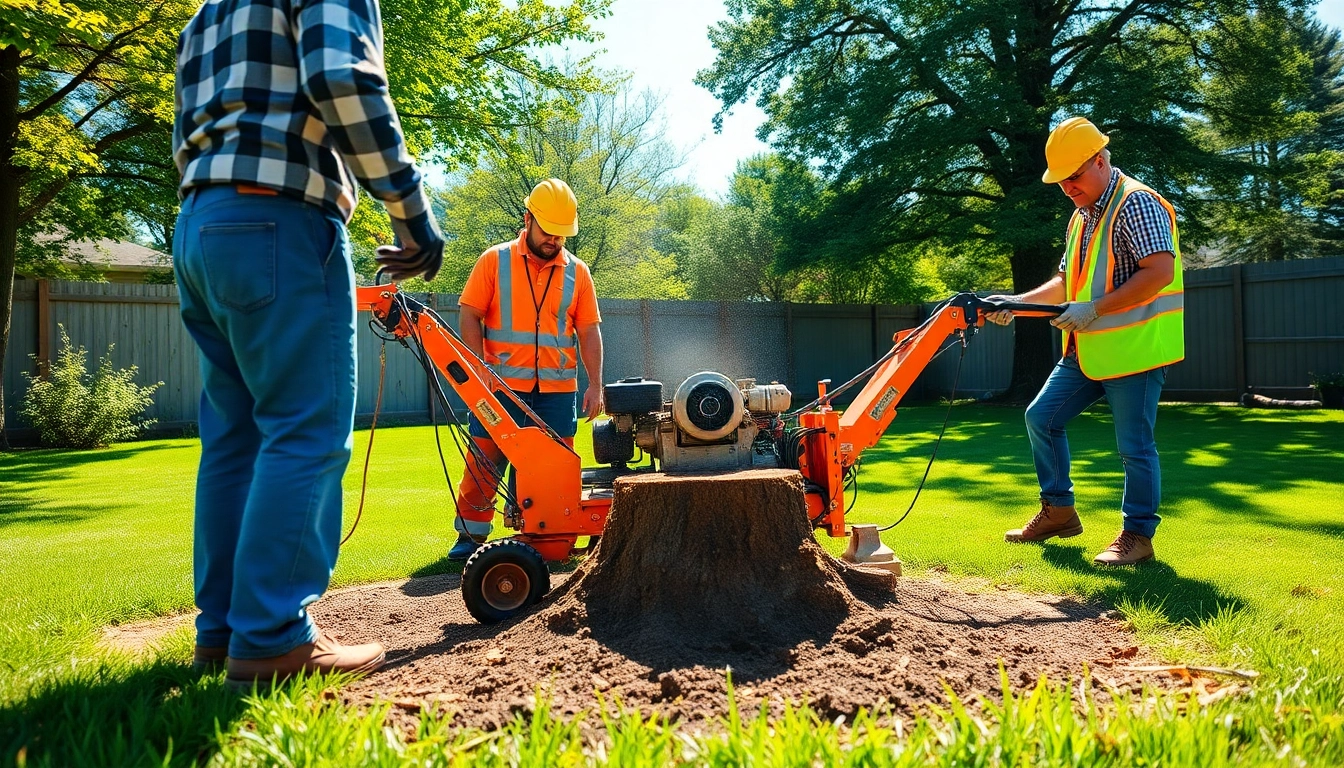Understanding Stump Grinding Services
What is Stump Grinding?
Stump grinding is a process used to remove tree stumps from the ground. Unlike traditional stump removal, which involves digging up the entire root system, stump grinding uses a specialized machine called a stump grinder. This equipment grinds the stump down into small wood chips, effectively clearing the area without the need for extensive digging and excavation. The resulting wood chips can be reused as mulch or compost. Essentially, stump grinding is a practical, efficient solution that minimizes disruption to your landscape while providing immediate results.
Benefits of Professional Stump Grinding
Hiring a stump grinding service has various benefits, particularly for homeowners or property managers. Here are some key advantages:
- Safety: Professional stump grinders are equipped with high-quality tools and trained personnel who understand the risks involved in stump grinding. This ensures that the job is done safely without accidents or injuries.
- Efficiency: Professionals can complete the task much quicker than a DIY approach. They have the experience to handle stumps of all sizes and will often finish the job in a few hours.
- Quality Work: When hiring professionals, you can expect high-quality workmanship. They know how to tackle even the most complicated stump removal challenges and understand how to preserve the surrounding landscape.
- Site Restoration: Beyond just grinding, many services also offer clean-up and turf restoration, leaving your property looking neat and tidy.
When to Consider Stump Grinding Services?
There are several scenarios where stump grinding services are particularly beneficial:
- After Tree Removal: Once a tree is cut down, you’re often left with an unsightly stump. Grinding it down can enhance the overall appearance of your yard.
- When Planning Landscape Changes: If you’re looking to redesign your garden or yard, removing stumps can free up space for new plants, structures, or features.
- Pest Control: Old stumps can attract pests like termites, ants, and beetles, which may jeopardize other plants in your landscape. Grinding them can help minimize these risks.
- To Prevent Injury: Stumps can be a tripping hazard, especially in areas where children or pets play. Grinding them down eliminates this safety risk.
Factors Influencing Stump Grinding Costs
Average Cost Expectation for Stump Grinding
The cost of stump grinding varies broadly based on several factors. On average, homeowners can expect to pay between $140 and $450.1 However, it’s important to recognize that prices can range significantly, depending on the specifics of the job. Factors contributing to the total cost include the size of the stump, the complexity of removal, and the geographical location.
Variables Affecting Pricing
Here are some primary variables that can impact the costs associated with stump grinding:
- Stump Size: Naturally, larger stumps require more time and effort to grind down, leading to higher costs.
- Location: The average cost of living in your area will influence the pricing. Urban areas tend to charge more than rural locations, primarily due to demand and availability of service providers.
- Root System: If the stump has a large or extensive root system, it may increase the difficulty and time needed for grinding, thus raising the cost.
- Access: The ease of access to the stump can greatly affect labor costs. Stumps located in tight spaces or hard-to-reach areas may require more work, leading to higher fees.
- Additional Services: If you require cleanup, disposal of debris, or landscaping services post-grinding, these will add to the overall expense.
Cost Comparisons: DIY vs. Professional Services
Many homeowners may consider the DIY approach to stump grinding. While renting the equipment might seem cost-effective, several factors often make hiring a professional a smarter choice:
- Equipment Costs: Renting a stump grinder can cost anywhere from $100 to $400 per day, not to mention the transport expenses and potential damage to the ground if not handled correctly. Professional services typically include all required equipment in their quoted prices.
- Expertise: Professionals have the training and experience to execute the job efficiently and safely, meaning they’re less likely to damage existing landscape features.
- Time Efficiency: A professional can often complete the job within a few hours, while a DIY effort may take significant personal time and physical labor.
- Long-term Vision: The quality of work and the restoration of the area post-grinding can have long-term implications; poorly managed or rushed DIY efforts can lead to more extensive landscaping costs down the line.
The Stump Grinding Process Explained
Preparation for Stump Grinding
Before the actual grinding process begins, several preparatory steps are taken to ensure a smooth and effective operation:
- Site Assessment: Professionals will first assess the stump and the surrounding area to identify potential hazards, obstacles, and the best approach.
- Clear the Area: It’s essential to clear a safe working space around the stump. This includes removing any debris, rocks, or plants that could interfere with the grinder.
- Check Utilities: Before grinding, it’s critical to check for underground utilities that could be damaged during the process.
- Equipment Setup: Professionals will arrive with their stump grinder and necessary safety gear, including helmets, goggles, and gloves, to start the job safely.
Step-by-Step of the Grinding Process
Once the preparation is complete, the grinding process can proceed, which generally involves the following steps:
- Positioning the Grinder: The grinder is positioned over the stump, and the machine is calibrated to grind away the upper section of the stump.
- Start Grinding: The operator begins grinding the stump, using a back-and-forth motion to chip the wood away gradually. This process continues until the stump is reduced to a depth of approximately 6-12 inches below ground level.
- Check for Roots: During grinding, the operator will monitor for large roots and may grind them as well to ensure a smooth surface.
- Cleansing the Area: After grinding, the operator will clear away the wood chips and any debris, restoring the area and making it ready for the next steps in your landscaping project.
Post-Grinding Cleanup and Yard Restoration
Once the stump grinding is completed, there are essential steps involved in cleanup and restoration:
- Disposal of Debris: Many services will take care of the wood chips and debris for you, or they may leave it on-site for you to repurpose as mulch.
- Fill the Hole: Professionals may fill the hole created from the grinding with topsoil or other materials to ensure the ground is stable and ready for planting grass or other terrain features.
- Restoration Check: A final check on the surrounding area to ensure everything is left neat, safe, and ready for future landscaping efforts.
Choosing the Right Stump Grinding Service
Key Qualities of a Reliable Stump Grinding Provider
Finding a reputable stump grinding company is crucial for ensuring quality and satisfaction. Here are some qualities to consider:
- Experience: Look for a provider with a proven track record in stump grinding services. Experienced companies are more likely to handle unexpected issues effectively.
- Licensing and Insurance: Always ensure that the company is fully licensed and insured. This provides protection for both parties in the case of accidents or damage.
- Positive Reviews: Research customer feedback online or seek referrals from friends and family to gauge the company’s reputation and quality of work.
- Detailed Estimates: A good provider should offer a clear estimate detailing the services provided and associated costs, eliminating surprises when the job is done.
Questions to Ask Before Hiring
Before committing to a stump grinding service, it’s prudent to ask important questions:
- How long have you been in the stump grinding business?
- Do you have the necessary licenses and insurance?
- Can you provide references from previous clients?
- What is the estimated timeline for the project?
- Will you take care of the debris removal after grinding?
- How do you handle any unexpected issues that may arise during the job?
Client Testimonials and Reviews
Reading testimonials and reviews from former clients can provide insightful information about the performance and reliability of a stump grinding service. Look for trends in feedback regarding satisfaction with the service provided, professionalism, and overall value. Highlighting specific instances of excellent or poor service can help you make a more informed decision.
Common Misconceptions About Stump Grinding
Myth vs. Reality: Stump Removal vs. Grinding
There are numerous myths surrounding stump removal that can mislead homeowners:
- Myth: Stump grinding is the same as stump removal.
- Reality: Grinding a stump leaves parts of the root in the ground, which can result in regrowth. In contrast, removal entails completely uprooting the stump and roots.
- Myth: Professional services are unnecessary; I can do it myself.
- Reality: Though renting equipment for DIY may seem cheaper upfront, it can lead to additional costs and safety risks if not executed properly.
Environmental Impact of Stump Grinding
It’s understandable to be concerned about environmental implications, but stump grinding is generally seen as environmentally friendly. The chips produced during the process can serve as mulch, enriching the soil and preventing erosion. Moreover, since tree remains are ground down rather than incinerated, this process minimizes air pollution that would otherwise result from burning.
Addressing Safety Concerns with Stump Grinding Services
Safety is a top priority for both service providers and homeowners. Professionals use specially designed equipment, safety gear, and advanced techniques to ensure that the grinding process does not endanger any nearby structures or individuals. Moreover, they are trained to handle potential hazards, like buried utility lines or unexpected plant growth in the area.


